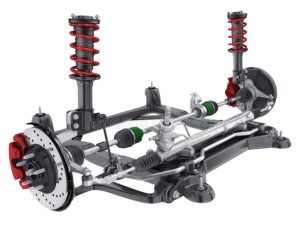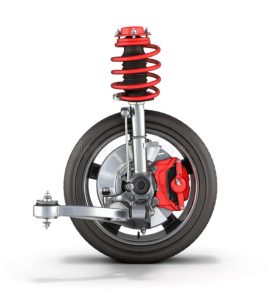Modern automotive engineering increasingly pushes toward lighter, stronger, and more efficient designs. In suspension systems — where both strength and dynamic response matter — choosing the right materials can deliver gains in performance, comfort, and efficiency. In this article, we’ll examine the science behind using lightweight materials in suspension components: what properties matter, which materials (aluminum, carbon fiber, advanced composites, hybrids) are being used, and the trade-offs that engineers must manage. We’ll also look at future directions and practical considerations.
Why Light Materials Matter in Suspension

Suspension components such as control arms, knuckles, springs, and links are part of the unsprung mass (mass not supported by the springs). Reducing unsprung mass is critical because it allows the tire to follow road contours more quickly, improves ride comfort, and enhances handling. Lighter components require less force to accelerate and decelerate, improving suspension responsiveness.
Additionally, reducing mass contributes to overall vehicle weight reduction, improving fuel economy or range (especially in electric vehicles). In lightweighting strategies, suspension design often plays a key role in achieving target mass reductions while preserving safety and durability.
To choose effective lightweight materials, engineers evaluate key material metrics:
| Metric | Importance in Suspension | Ideal Behavior |
|---|---|---|
| Specific Strength (strength per unit weight) | Determines how much load a part can carry relative to its mass | High |
| Specific Stiffness (modulus per unit density) | Stiffness relative to weight, affects flex, deflection, and dynamic response | High |
| Fatigue Resistance | Suspension components see repeated load cycles | High durability under cyclic loading |
| Corrosion Resistance | Exposure to weather, road salts, moisture | High resistance or protective coatings |
| Manufacturability & Cost | Feasibility for shaping, joining, finishing, and cost implications | Reasonable for production |
Aluminum Alloys: The Proven Lightweight Workhorse
Aluminum is perhaps the most widely used lightweight metal in automotive suspension design, thanks to its mature production infrastructure and favorable balance of weight, strength, and cost. Typical alloys like 6xxx or 7xxx series provide good strength, corrosion resistance (especially when anodized), and workability.
Advantages of Aluminum in Suspensions:
-
Density (~2.7 g/cm³) is much lower than steel, so parts can be lighter (e.g. control arms, trailing arms).
-
Good stiffness-to-weight ratio for many suspension geometries.
-
Corrosion resistance (native oxide) and ability to use coatings.
-
Compatibility with conventional machining, forging, casting, and joining methods.
Challenges and design considerations:
-
Aluminum is less stiff (lower Young’s modulus) than steel, so geometry must often be scaled (thicker sections, optimized shapes) to attain equivalent stiffness.
-
Fatigue performance must be addressed through proper geometry, surface treatments, and load path design.
-
Joining dissimilar materials (aluminum to steel or composite) and managing galvanic corrosion can be tricky.
Aluminum remains a go-to choice for many OEM suspension links, brackets, and subframe components.
Carbon Fiber and Composite Materials: The Cutting Edge
Carbon fiber–reinforced polymer (CFRP) and composite materials are progressively being adopted in high-performance and premium vehicles for suspension and structural parts. Their appeal lies in extremely high specific strength and stiffness when engineered appropriately.
Key features of carbon fiber composites in suspension:
-
Low density: Typical CFRP composites may have density ~1.5–1.7 g/cm³, much lighter than aluminum.
-
High specific stiffness and strength: For certain load directions, CFRP can outperform metals in stiffness or strength per unit weight.
-
Tailored fiber orientation: Engineers can orient fibers in load directions (unidirectional, bidirectional) to optimize strength, stiffness, and vibration damping characteristics.
-
Corrosion inertness: Carbon composites don’t corrode like metals (though the matrix may degrade under UV or thermal aging).
Limitations and challenges:
-
Composites are anisotropic — the properties depend strongly on fiber orientation and layup. Designing for complex multi-axis loads (as in suspension joints) is more demanding.
-
Cost is higher (raw materials, curing, tooling) compared with metals.
-
Damage tolerance and impact resistance must be carefully engineered — composites may crack or delaminate under unexpected loads.
-
Repair is more difficult than metals; damage is less obvious.
-
Junctions, joints, and control of tolerances can be complex when interfacing with metal hardware.
Still, some suspension components — control arms, anti-roll bar arms, or even spring elements — have been made with carbon or hybrid composite-metal structures in performance and racing cars.
Hybrid Materials & Advanced Alternatives
Beyond pure aluminum or carbon fiber, engineers now explore hybrid and composite-metal combinations to balance advantage and mitigate drawbacks.
Hybrid approaches:
-
Fiber-metal laminates (FMLs) such as GLARE (glass-fiber + aluminum) combine metal and composite layers to get benefits of both (stiffness, damage tolerance, corrosion resistance).
-
Carbon + metal inserts: Composite arms with metallic mounting bosses or inserts for high-load zones.
-
Metal matrix composites: Aluminum or magnesium matrices reinforced with ceramic or fiber phases to increase stiffness and strength.
-
Exotic materials: Combinations like “Carbotanium” (carbon + titanium) exist in ultra-high-end applications to push strength and thermal stability boundaries.
-
Ultra-light lattice or microlattice structures: Advanced architectures (e.g. metallic microlattices) can create extremely light yet stiff structures for future suspension elements.
Using hybrid or architected materials allows designers to place strength where needed, and reduce material in less-critical zones, extracting more performance per gram.
Comparison of Materials for Suspension Use
Here’s a comparative look:
| Material / Structure | Density (approx) | Strength or Stiffness Traits | Pros | Cons / Challenges |
|---|---|---|---|---|
| Steel (baseline) | ~7.8 g/cm³ | Good strength, stiffness | Very established, cost-effective | Heavy, corrosion-prone |
| Aluminum alloys | ~2.7 g/cm³ | Moderate stiffness | Good compromise, mature tech | Lower stiffness, fatigue concerns |
| CFRP composites | ~1.5–1.7 g/cm³ | Very high specific stiffness | Lightweight, strong, custom orientation | Cost, repairability, anisotropy |
| Fiber-metal laminates | ~2.0–3.0 g/cm³ (varies) | Hybrid strength | Improved damage tolerance, hybrid benefits | Complexity in layering, bonding |
| Metal-matrix composites | variable | Elevated modulus over metal | Better stiffness/strength | Manufacturing cost, brittleness trade-offs |
| Microlattice materials | extremely low density | Still being matured | Ultra-light, potential in niche roles | Experimental, production scale, durability |
In practice, a suspension component designer will select geometry, cross-section, and material together to meet constraints of stiffness, strength, fatigue life, cost, and manufacturability.
Practical Use Cases and Examples
-
Performance/track vehicles: Composite control arms or end links that reduce rotating mass and improve responsiveness.
-
Luxury cars: Hybrid structures that improve NVH (noise, vibration) by reducing mass while preserving stiffness.
-
Electric vehicles: Weight savings in suspension help offset battery weight and improve range.
-
Motorsport and racing: Custom carbon or laminate suspension arms, uprights, or linkage elements are fairly common in high-end racecraft.
-
Advanced prototypes or concept cars often test new composite or lattice structures to validate future production designs.
Trade-Offs & Engineering Challenges
When using lightweight or composite materials, designers must manage trade-offs carefully:
-
Cost vs performance: Composites and hybrids are more expensive in material cost, tooling, and quality control.
-
Durability and fatigue: Metal parts often have well-understood fatigue models; composites require advanced analysis to ensure long life under cyclic loads.
-
Damage detection and repair: Composite damage may not be obvious; non-destructive inspection methods are needed.
-
Thermal, UV, and environmental stability: Polymers degrade under heat or UV, so protective coatings and matrix selection is critical.
-
Joining and integration: Attaching composite parts to metal subframes or interfaces must be carefully engineered to handle differences in stiffness, thermal expansion, and load transfer.
Design Guidelines for Lightweight Suspension Components

To use lightweight materials effectively, engineers follow certain guidelines:
-
Use finite element analysis (FEA) to optimize shape and thickness distributions.
-
Prioritize load path continuity — avoid abrupt transitions that concentrate stress.
-
Place fibers or reinforcement along principal load directions.
-
Add repairability or damage tolerance consideration — reserve area for inspection or replacement.
-
Use protective coatings or layers (gel coats, UV barriers) for composite surfaces.
-
Thorough testing (static, fatigue, environmental) is critical before deployment.
Conclusion & Future Outlook
Lightweight materials in suspension design — aluminum, carbon fiber, hybrids, and emerging architectures — offer a pathway to dramatic performance, efficiency, and handling gains. By reducing unsprung mass, optimizing stiffness, and carefully controlling dynamic response, engineers can deliver suspensions that feel more responsive without compromising comfort or durability.
However, these gains come with higher complexity, cost, and material-specific challenges. The most successful designs balance material choice, geometry, manufacturability, and long-term reliability.
As composites, hybrid architectures, and novel materials like microlattices mature, the future of suspension design may bring even more radical weight savings and performance advancements.
If you’re looking to source advanced suspension modules or components built for performance and lightweight design, you can Buy Suspension online to find quality parts that align with modern lightweight suspension strategies.